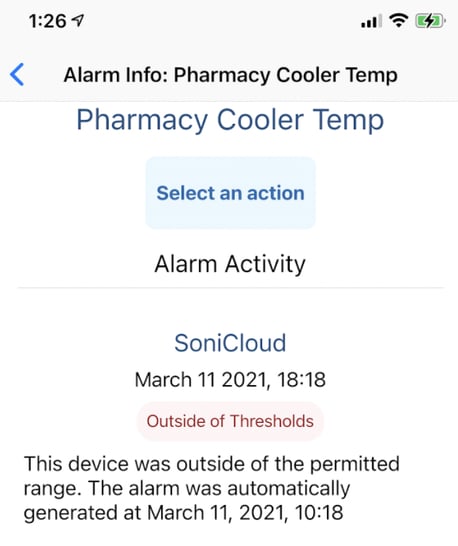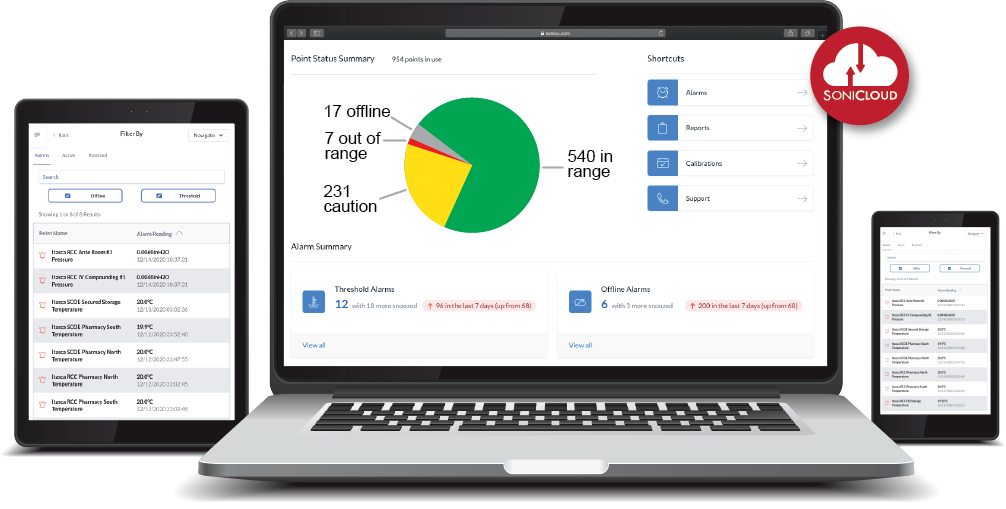
Identifying Open Door Threats in the OR to Reduce Surgical Site Infections
Operating rooms may be among the most tightly regulated environments in healthcare facilities, Sonicy helps ensure they're safe and monitored correctly.
Designed with safety, efficiency and compliance always top of mind, we’ve evolved over a decade with continuous improvements from customer feedback. Serving the healthcare, research and food service industries.
Sonicu offers a comprehensive suite of monitoring solutions
that help organizations safeguard assets, automate compliance and reduce manual processes.
Sonicu offers a comprehensive suite of monitoring solutions
that help organizations safeguard assets, automate compliance and reduce manual processes.
From protecting vaccines and research materials to safeguarding food service and facility operations, Sonicu’s monitoring applications cover temperature, humidity, pressure, and more. Whether you’re in healthcare, life sciences, food safety, or other industries, Sonicu provides visibility, compliance, and peace of mind across all your critical applications.

Understanding Heat Stress and OSHA Regulations: How to Protect Your Employees and Ensure Compliance

In the wake of pandemic-induced shutdowns, the digitalization of the restaurant industry is helping owners get back on their feet and tackle continuing challenges.
The coronavirus pandemic has accelerated digital growth within the food service industry at a rate no one had predicted.
Adoption of ‘Internet of Things’ technologies like remote sensors, analytical software, and omni-channel delivery platforms has been instrumental in helping to alleviate labor shortages, supply chain issues, and ongoing customer behavior changes.
While the accelerated advancements have been great, there is more to be done.

The Pandemic Impact: Improving Efficiency and Tackling Staffing Challenges
The pandemic is still here, presumably long-term, and the same challenges from March 2020 still exist.
The first year of the coronavirus pandemic, COVID-19, brought the restaurant industry to a halt, the likes of which haven’t been seen since World War II. Year two brought vaccine administration and easing of restrictions for indoor dining, allowing customers to return to their favorite places.
Hope for normalcy was dispelled by new variants surfacing and impeding the fast recovery that was once anticipated.
More than halfway into year three with booster shots offering improved prospects of some semblance of normalcy, the omicron variant has spread at a rapid pace, and threats continue to silence hope of progress.
It is likely we will continue to see issues like a spike in infection rates, labor shortages, supply chain disruptions, and price increases, all brought on by the pandemic plaguing restaurants.
According to OpenTable, in early 2022, customer concerns over the omicron variant caused table reservations to drop by:
These figures are in comparison to the same timeframe in 2019.

An Age of Restaurant Closures and Disruptions
The National Restaurant Association reports that in the first six months of the pandemic, nearly one in six restaurants shut down.
That’s nearly 100,000 restaurants and bars that have shut down since the start of the pandemic.
Even chain restaurants like McDonald’s have been affected, having to close some locations due to labor shortages.
For those not closing, they were reliant on take-out orders.
Food delivery services became the backbone of stay-at-home orders implemented by the government, but they bring unique challenges.
People’s trust in the food handling process and delivery methods, along with a demand for contactless transactions, were of utmost importance for those using restaurants' home delivery services.
With the cusp of US supply chain disruptions nowhere in sight, it’s undeniably affecting in-store and takeout experiences.
Essential food service products may be out of stock or priced beyond profit margins.
From fresh produce to meats to paper products such as coffee cups, straws, and takeaway containers, restaurant owners continue to experience shortages and increasing prices.
For restaurants, this means jeopardizing a menu’s signature dishes, compromising meal quality for takeout orders, and/or generally disappointing customers.
Taylor Morabito, the owner of New York's famed Friend of a Farmer restaurant, said,
"I think the biggest challenge the industry currently faces is the drastic increase in food cost, specifically within the world of poultry, meat & fish. Products that used to cost $11 or $12 a pound have doubled &, in some cases, nearly tripled in price.
Unfortunately, with the current supply chain issues & rising inflation, I believe that restaurant owners and management will be navigating around this particular challenge for quite some time."
Shortages of essential equipment like HVAC units and their replacement parts also require ongoing monitoring and maintenance of existing inventories to prevent failure and food safety risks.
Thankfully, the internet of things (IoT) and digital technologies like affordable temperature monitoring can help automate many aspects of supply chain management for restaurants and their suppliers.
In addition to the supply chain issues, restaurants will continue to struggle with the issue affecting all industries: the labor shortage.
While hiring and retaining employees has always been an issue within the food service industry it has been exponentially more difficult during the pandemic.
The initial closure of many restaurants led to former employees finding jobs in alternative industries.
Attempts to convince new and former employees to return have proven challenging due to reduced hours and tips, as well as the personal risk of potential infection and troublesome customers who, at times, can become violent when faced with mask and/or vaccine mandates.
Remembering that more than 900,000 people died in the U.S makes consideration for long-term solutions the top priority for those in the food service industry.
The number of employees willing to work is such a challenging situation that some restaurants are forced to operate with shorter hours and fewer days.
"If you look at who is working in restaurants in 2019 versus today, there are about a million people who have disappeared," said Micheline Maynard, Washington Post columnist and author of the book "Satisfaction Guaranteed: How Zingerman's Built A Corner Deli Into a Global Food Community".

Combating These Challenges: Affordable and Trusted Temperature Monitoring
Pending the idea that restaurants continue to be understaffed, how can maximum productivity be achieved with fewer people?
With smaller teams and limited resources, restaurants must prioritize investing in technology that will optimize operations and help team members maximize time and efficiency while continuing to deliver a premium customer experience.
Sonicu currently supports dozens of food service clients with our simple and affordable solution that makes it easy to protect your inventory and streamline regulatory compliance.
The past two years have completely changed the way people think and function.
In some regards, it has also altered people's expectations of the restaurant business.
With contactless payment methods and online orders, people have become more dependent on technology than before. Surviving during the pandemic and shutdowns meant restaurants were offering enhanced discounts as many customers shifted to online or app ordering.
Now, in 2022, many customers are used to this and expect restaurants to continue discounting and offering extra reward incentives.
Much of the technology discussed, such as apps, third-party ordering, and direct online ordering, has been used for several years.
Unfortunately, it took COVID-19 to force the restaurant industry to exploit its use to a fuller extent.
Now, this adaptability of technology is paving the way for recovery and growth.
Technology became the answer to addressing a lot of issues restaurants faced during the pandemic. The technological owners shifted their menus online and increased delivery to stay open.
While this is a positive trend for 2022, there are other issues to be addressed if the restaurant industry is to be saved.
Overall, 2022 is proving to trend in the right direction, demonstrating the resiliency of the restaurant industry.
Outside Sources:
COVID-19 pandemic exposes new challenges for restaurant industry - ABC News (go.com)
Trends Affecting The Restaurant Industry In 2022 (forbes.com)
Subscribe to our newsletter for expert insights, product updates, and strategies to keep your operations running smoothly.

